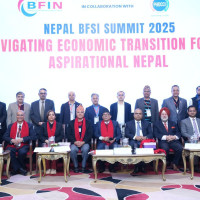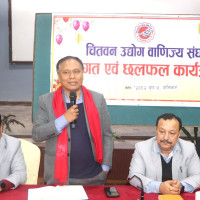- Sunday, 21 December 2025
Agricultural Revolution In Nepal
Opportunities, Challenges And Way Ahead
Nepal is an agricultural country. The agricultural sector is the main base for achieving economic prosperity, contributing 27% to the GDP, and is associated with the livelihood of nearly two-thirds of the country's population. The country's agricultural sector is on the road to transformation, albeit gradually, due to strong factors such as geographic diversity, a large number of working-age citizens, growing political interest in agricultural development, and increasing mechanisation, diversification, and commercialization in agriculture. But until a few decades ago, the country was not only self-sufficient in agricultural products such as rice and wheat, but it also used to earn foreign currency by exporting agricultural products. Facing the challenges seen in the agricultural sector, it is now necessary to develop the agricultural sector as a competitive, environmentally friendly, self-sufficient, and export-oriented industry.
The Agricultural Revolution was a revolution in the 18th century in Britain that led to the mechanisation and industrialization of agriculture to increase agricultural production. The agricultural revolution is considered to have started with Jethro Tull's invention of the drill machine in 1701.
In the present context, the definition of agricultural revolution is broad. Solving problems such as growing population, limited arable land, growing distaste for agriculture, the development of new techniques, and the use of advanced technologies to greatly increase the production and productivity of the entire agricultural sector is actually an agricultural revolution. To promote commercial farming according to climate, environment, and soil, developing skilled manpower and developing technology-friendly agricultural businesses is the real agricultural revolution. For the development of the agricultural sector, the investment and interest of public and private bodies are necessary for the development of agricultural businesses based on knowledge gained through policy reforms, infrastructure development, market management, and the management of industries.
The Constitution of Nepal 2072 has considered the agricultural sector a common right of the federal government, provinces, and local bodies. This arrangement of the constitution is appropriate to address the different agricultural possibilities in different geographical areas. Land management, agricultural insurance, support prices for production, irrigation management, supply of fertiliser, pocket area drainage, construction of wet houses, protection of crops and livestock, breeding and breed improvement, farmer pension, etc. A joint effort is required. The Agricultural Development Strategy (Year 2015–2035), which is a roadmap for the development of the entire agricultural sector of Nepal, aims to make the agricultural sector of the entire country self-sufficient and the main source of foreign exchange through commercialization, mechanisation, and diversification of agricultural and livestock products. Ministry of Agriculture, Ministry of Finance, Nepal Agricultural Research Council, National Farmers' Commission, etc. have been working for the development of the agricultural sector of the country from planning to its implementation.
Industrialisation For Agriculture Sector’s Improvement
The need for mechanisation and industrialization has been felt to address this, as the traditional farming system requires a lot of manpower and time consumption but has a low total output. There is a need for industrialization to increase the value and life of the products by processing them on a large scale and making them sustainable and safe. Israel is the country that has made the highest use of mechanisation and industrialization in the agricultural sector. Most of the country is desert; only 20% of Israel's land is arable. According to the Israeli Central Bureau of Statistics, Israel's agricultural exports in 2020 were worth $3.3 billion.
Israel has a unique agricultural style, characterised by its use of advanced technology and irrigation methods, as well as its focus on high-value crops and exports. One of the key features of Israeli agriculture is its use of precision agriculture and irrigation techniques. These technologies allow farmers to optimise crop yields using the fewest resources and conserve water resources. Nepal also needs to adopt similar scientific agricultural methods. To promote the production and productivity of the land by using technology in the production, conservation, and management of the agricultural sector, the development of an investment-friendly agricultural sector is necessary.
Challenges For Nepal's Agriculture Development
Inadequate infrastructure and brain drain: Nepal has limited infrastructure, especially in rural areas, which makes it difficult for farmers to transport their products to the market. This results in low prices, leading to decreased income and poverty. The lack of storage facilities, processing facilities, and transportation infrastructure also affects the quality of the products and the farmers' ability to reach wider markets. In addition, the brain drain of skilled people who are skilled to work in agriculture and can contribute to infrastructure construction has added more challenges to the development of the agricultural sector.
Policy formulation and implementation: The agricultural sector in Nepal faces numerous challenges in both policy formulation and implementation. Political instability and changes in government policies, limited financial and technical resources, fragmented land ownership, poor infrastructure, limited adoption of technology, the impacts of climate change, and inefficient market systems are some of the major obstacles to the development of the agriculture sector in Nepal. Addressing these challenges requires a comprehensive approach and sustained efforts from both the government and other stakeholders in the sector.
Efficient use of the common rights granted in constitution: In Nepal, the effective use of common rights related to agriculture has become a challenge due to limited coordination between various levels of government, a lack of technical and financial resources, political interference, and corruption.
Limited access to technology: Most Nepalese farmers are still using traditional farming practises, which are less efficient and productive than modern methods. Farmers have limited access to modern technologies such as tractors, irrigation systems, and fertilisers, which makes it challenging for them to increase their yields and improve the quality of their products.
Arable land management: The villages are being emptied as the youth migrate abroad for foreign employment and the people from the villages move to the cities in search of facilities and opportunities. Along with this, the agricultural lands of the village are barren. How do I solve it? This connection has been raised recently. Giving my example. I was at home in Myagdi because the offices were closed during the Corona pandemic. We decided to plant bananas on the uncultivated land in the village during our free time. We planted nearly 500 banana plants. Now that the vacant land has been established as a banana plantation, This year alone, bananas worth nearly 1 lakh rupees have been produced.
Economic growth of the country is possible only if the country's economic growth is increased by planting plants such as grass plants, valuable wood, short-term fruits, cardamom, etc. on the empty land. The main challenge of today is to create an environment for the government to deliver these things to the villages as a campaign. Recently, the work of developing arable land in the form of plots has increased rapidly. The government alone can't solve this problem.
Low Agricultural Productivity: Nepal's agriculture sector is characterised by low productivity and low yields. This is due to a lack of investment in research and development, limited access to credit and other financial services, and a lack of extension services. These factors result in low-quality products, low income for farmers, and the weak competitiveness of Nepalese agricultural products in the global market.
Lack of Market Access: Most Nepalese farmers are not connected to market systems, and they often sell their products at low prices to middlemen. This results in low income for farmers and a lack of investment in the sector. The lack of market access also affects the quality of the products and makes it difficult for Nepalese farmers to reach wider markets. A few days ago, in Chitwan, farmers protested by throwing vegetables on the road, saying that the vegetables they produced were not getting proper market rates. In Nepal, vegetables are imported in large quantities from India, but there is a problem that domestic products do not get a market or a price. Solving this problem is a big challenge in the agricultural sector.
Product Pricing: Generally, according to the economic pricing theory, prices are determined by demand, supply, and interest. However, in commercial agriculture, it is necessary to emphasise practical rather than classical aspects. Professionalism in agriculture happens when the farmer gets a fair price for his produce. This means that farmers investments are safe. However, in our country, the authority for price determination is obtained from the so-called middlemen. The wholesale price of vegetables in the Kalimati vegetable market is determined according to the interest of the middleman. As a result, from time to time, farmers dump their produce on the road. Therefore, the minimum price should be set by the government to ensure that the farmers invest in their products. Compulsory insurance of agricultural products should be done. In case of damage, the concerned farmers should get compensation.
Climate Change: Nepal is highly vulnerable to the impacts of climate change, and its agriculture sector is no exception. The country experiences extreme weather conditions like droughts, floods, and erratic rainfall patterns, which affect crop production. In recent years, there have been more frequent and severe weather events, leading to reduced yields, soil degradation, and the loss of valuable crops.
Road Ahead
The Government of Nepal has recognised the need for modernization of the agricultural sector and has initiated various initiatives from the government and private sectors to achieve this goal. One of the key objectives is to increase agricultural productivity and profitability, which can be achieved through the adoption of modern technologies and practises, such as precision agriculture, organic farming, and agroforestry.
The government has also launched several programmes to promote the development of value chains, such as the One Village, One Product (OVOP) scheme, which aims to encourage entrepreneurship in rural areas. This will not only improve the livelihoods of rural communities but also boost the growth of small and medium-sized enterprises (SMEs) in the country. The government is willing to implement many programmes, including agricultural insurance programmes, farmer pension programmes, and agricultural concessional loans.
Another important aspect of the agriculture sector in Nepal is the development of the livestock sector. This is crucial for the country's economy, as livestock products are a major source of income for rural communities. The government has launched several initiatives to promote the development of the livestock sector, such as the Livestock Sector Development Programme, which aims to improve the productivity and profitability of livestock production through the adoption of modern technologies and practises. The private sector is gradually investing in the agricultural sector, increasing income by processing agricultural products. The increasing investment of labour and capital is gradually affecting the agricultural sector.
Moreover, the government has also launched programmes to promote agroforestry and organic farming in Nepal. These initiatives aim to promote sustainable agriculture practises and reduce the negative impacts of climate change on the sector. Additionally, the government has introduced new policies and regulations to ensure that agricultural products are safe and of high quality, thereby improving their competitiveness in the global market. The government has moved forward by creating a plan for a sustainable, competitive, and prosperous agricultural economy with food and nutrition security and food sovereignty.
In conclusion, the future of agriculture in Nepal is promising, as the government is making significant efforts to modernise and develop the sector. The adoption of modern technologies, practises, and policies will help to increase agricultural productivity and profitability, promote sustainable agriculture practises, and improve the livelihoods of rural communities. A revolution will come to the agricultural sector of Nepal only with the joint efforts of the government sector, the private sector, and civil society. The upcoming path of agriculture development in Nepal will bring new opportunities and challenges, but with the right support, it has the potential to transform the economy and the lives of the Nepalese people.
(Subedi is a student of Economics)















